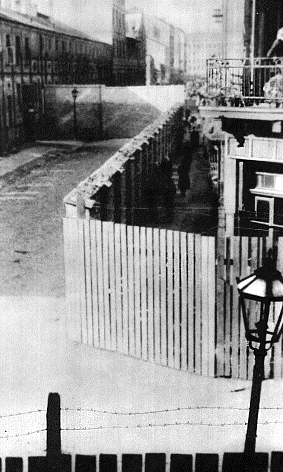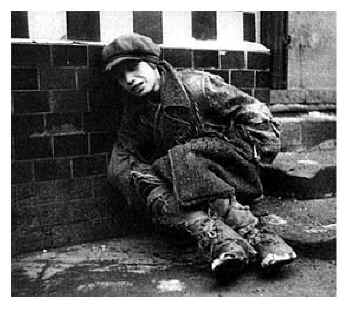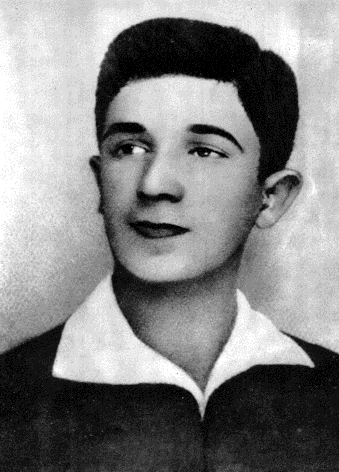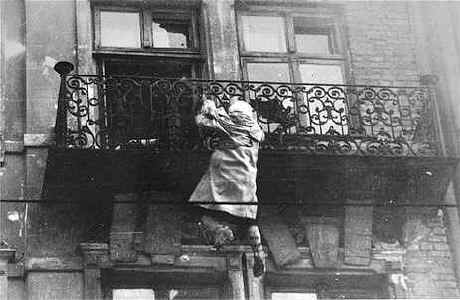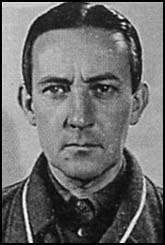|
|
|
| In September of 1939 Poland was Invaded by the Nazis. | |
| By October in 1940, they held around 400,000 Jews into a 3.5 square mile area in Warsaw, which is only supposed to have around 160,000. The Jews weren't allowed to have any contact with anyone outside the walls of the ghetto. They were also forbidden to go outside of the area, because if they did they had a penalty of being shot on first sight. | |
| In mid-November of 1940 the Nazis had established a ghetto. The Jews were told to be in the same part of the city. Then the Nazis had sealed off the rest of the city with a medieval 10 foot high wall. To the Jews it was like moving into a prison and they weren't allowed out. One inhabitant had wrote, "We are segregated and separated from the world and the fullness thereof, driven out of society of the human race." |
A little section of the wall of the Warsaw ghetto.
|
| The Nazi governor which is called a Gauleiter was Hans Frank of occupied Poland, declared in 1941, "I ask nothing of the Jews except that they should disappear." | |
| In November of 1941 the Nazis had went very far to enforce the penalty of death for Jews found past the ghetto wall. They had heard very little about what happened outside the ghetto walls. To make sure of this the Nazis had taken away radios, telephone lines, censored mail and frequently confiscated packages coming in. | |
| The ghetto was in poor looking conditions. It was at the point where there was 400,000 Jews crowded inside the walls of the ghetto. Many families lived in one apartment, and were unable to purchase food on the open market. They had to depend on the Nazis to give them food. The Nazis had refused to allow enough food into the ghetto to keep them healthy. In which they only feed the Jews a bowl of soup a day to survive on. The Germans had made it their policy to keep the Jews on the attempt of starving. The Nazi occupation authorities had instructions to give Jews half of the weekly maximum of food allowance needed by a "population which doesn't work worth mentioning. "In months, the overcrowding, hunger, very small amount of medical supplies and fuel shortages had a bad effect. Around 300 to 400 Jews were dying each day because of all of this. |
A boy dying of starvation.
|
| In 1941, typhus epidemics, started in the institutional buildings and synagogues housing the homeless had destroyed the ghetto. Human waste was dumped onto the street when the sewage pipes had froze. By the end of 1941, disease killed about 10% of the ghetto's population. (43,000) | |
| In Spring of 1941, Jews employed in workshops set up by Germans. They were created to support the German war effort. The Jews that employed were saved from the first deportations to the death centers, but they were transported in the summer of 1942. | |
| On July 20th they issued an order for "non-productive" elements to get ready for a "resettlement" program that would begin two days later. That order prevented widespread panic throughout the whole ghetto. The Jews that didn't have work cards tried to find them as soon as they possibly could. The head of the Jewish council committed suicide when he was ordered to organize the deportations. Also on the very same day a group of Jewish leaders got together to discuss whether or not to resist the orders. Most of them had decided not to, and most had thought that the Germans were going to take no more than 60,000 people. It was agreed to that the resistance would hasten simply to the end of the ghetto. Between the meeting and the middle of September the Nazis deported more than 300,000 Jews from the ghetto, and most of them were taken to a Treblinka death camp. By fall of 1942, almost all the factions in the ghetto decided to resist deportations in the future. Each of the political groups formed its own "battle group" which came from central commander Mordecai Anielewicz, 24 years old. The armed resistance got ready for the conflict by using shelters and bunkers. By suddenly deporting 6,500 Jews, the Nazis surprised the Jewish fighters in January 1943. But those Jews remaining knew by now that deportation meant death so they chose to resist. A Jewish Fighting Organization called ZOB was formed. It had consisted of 22 groups, each of the groups contained 20-30 men, boys, and some women. The group sent for weapons from the anti-Nazi Poles outside of the ghetto. They had been supplied with enough weapons to successfully stop deportation by attacking from rooftops, cellars, and attics. They had killed 20 Germans and wounded 50 as a result. The Jewish resistance, combined with severe winter weather and a shortage of trains, it prevented the SS from meeting Himmler's February deadline. |
Mordecai Anielewicz
|
| Himmler had ordered the SS to give a "special action" against the Jews that would wipe out the entire ghetto in just 3 days, in the spring. By now the ghetto size was reduced to a measurement of only 1,000 yards by 300 yards. | |
| When a German police officer was badly injured, the planned mass deportation came to a stop. Heinrich Himmler was enraged by the incident that he ordered the liquidation of the ghetto. The emptied district was then to be razed to the ground. | |
| On Monday April 19,1943 at 3a.m. the ghetto was surrounded by the Nazis. There was more than 2,000 Waffen SS soldiers under the command of General Jurgen Stroop attacked the Jews. The German were armed with two armored cars, a tank, 3 light anti-aircraft guns, one medium howitzer, flame throwers, heavy and light machine guns, rifles, grenades, and pistols were up against only 700-750 Jewish resistance fighters. The Jews had managed to stock up on a few thousand grenades, and a few hundred rifles, pistols and revolvers. But they had only a few light machine guns. They also had Molotov cocktails. The plan for the Germans was to clear out 60,000 Jews in 3 days, but Jews hoped to hold out as long as they possibly could. The Jews had killed 12 Germans. The Germans renewed the attack. They found it was difficult to kill or even capture the small battle groups. The ones that fought, then retreat through a maze of cellars, sewers, and many different other passageways to escape being captured. By the 5th Himmler was infuriated so he ordered the SS to brush out the ghetto" with the greatest severity and relentless tenacity." So the SS General Stroop had decided just to burn down the entire ghetto block by block. By April 22nd, fire was demolishing several parts of the ghetto, which was forcing many Jews to jump out of burning buildings. Into the next few days, the Germans were capturing and killing more and more of the ghetto Jews. Which Germans had reported that some resistance fighters in bunkers became "insane from the heat, the smoke, and the explosions." Even though some Jews had tried to escape through the sewers the Germans had responded by using poison gas and blowing up the manholes. Anielewicz was killed on May 8th. It was clear that the ghetto fighters had been defeated on May 15th when shooting had become so intermittent. | |
A report filed by Stroop described the scene:
|
A lady hanging from her apartment building getting ready to jump.
|
Even though the burnings and renewed German attacks
continued, the Jews of Warsaw held on for a total of 28 days. On May
16,1943, the Jewish resistance finally had ended. Stroop had then sent a
battle report saying,
Around 30,000 of Jews were either shot or transported to death camps. " Polish sources estimated around 300 Germans were killed and 1,000 were wounded. |
Jurgen Stroop
|
The resistance fighters had achieved at least one of
their goals even though the Nazis did raze the ghetto as Himmler had
ordered. The Jewish commander Anielewicz had said in a letter to a
friend shortly before his death,
By the end of the year with hardly any Jewish resistance became in the words of one member of the underground to,
|
|

